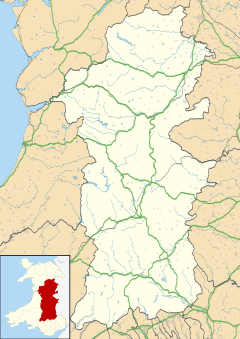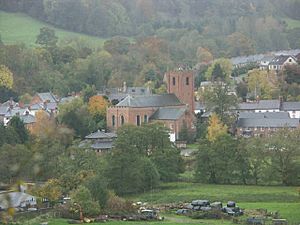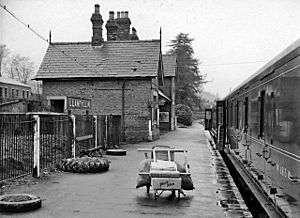Llanfyllin facts for kids
Quick facts for kids Llanfyllin |
|
|---|---|
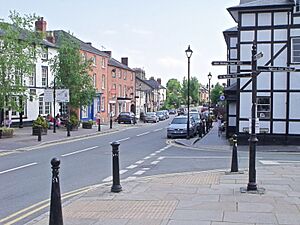 Llanfyllin Town Centre |
|
| Population | 1,586 |
| Language | Welsh English |
| • London | 180 mi (290 km) |
| Principal area | |
| Ceremonial county | |
| Country | Wales |
| Sovereign state | United Kingdom |
| Post town | LLANFYLLIN |
| Postcode district | SY22 |
| Police | Dyfed-Powys |
| Fire | Mid and West Wales |
| Ambulance | Welsh |
| EU Parliament | Wales |
| UK Parliament |
|
| Welsh Assembly |
|
| Website | llanfyllin.org |
Llanfyllin (pronounced 'Hlan-vull-in') is a small market town and community in Powys, Wales. The town's name means 'church or parish of St Myllin'. In Welsh, the 'm' sound often changes to 'f' in place names. In 2021, about 1,586 people lived in the community, which covers an area of 41.8 square kilometres. The community includes places like Bodfach and Ty Crwyn.
Contents
- Geography: Where is Llanfyllin located?
- History: What is Llanfyllin's past?
- Buildings: What are Llanfyllin's notable structures?
- Notable People: Who are famous from Llanfyllin?
- Governance: How is Llanfyllin governed?
- Education: What schools are in Llanfyllin?
- Transport: How do people travel in Llanfyllin?
- The Lonely Tree of Llanfyllin
- Images for kids
- See also
Geography: Where is Llanfyllin located?
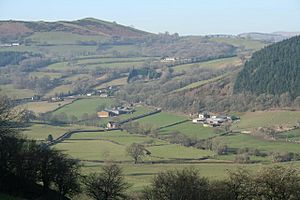
Llanfyllin is nestled in the valley of the River Cain. This area is close to the Berwyn Mountains in Montgomeryshire. The town is about 14 miles (22.5 km) southwest of Oswestry. It is also about 15 miles (24 km) from Montgomery.
The River Cain flows through the valley. A smaller river, the River Abel, joins the Cain in Llanfyllin. The River Cain then flows into the River Vyrnwy at Llansantffraid.
History: What is Llanfyllin's past?
Llanfyllin is located between Shrewsbury and Bala. These two towns were important market centres in Wales and the Welsh borders for a long time. Near Llanfyllin, at a place called Bodyddon, there is evidence of an early British settlement.
Some historians think Llanfyllin might be the ancient Roman town "Mediolanum". This town was mentioned in a very old book called Geography around 150 AD. However, other places like Meifod or Caersws are also thought to be Mediolanum.
The Holy Well and St Myllin
The town is famous for its holy well, called Fynnon Coed y Llan. People believe that Saint Myllin baptised people here in the 6th century. The main church in Llanfyllin is also named after Saint Myllin.
Some stories say Saint Myllin was an Irish bishop named Saint Mo Ling. He lived from 614 to 697. But this is not certain. There are no records of Mo Ling visiting Wales. Also, people believe Myllin is buried under the altar of Llanfyllin church. Mo Ling, however, is thought to be buried in Ireland.
Medieval Castle and Town Charter
A motte and bailey castle called Tomen yr Allt once stood near Llanfyllin. This type of castle was common in the Middle Ages. It was probably destroyed in 1257 by Llywelyn ap Gruffudd, a Welsh prince. You can still see the earthworks of the castle today.
Llanfyllin became a market town in 1293. It received a special document called a charter from Llywelyn ap Dafydd. This was during the time of King Edward I. Llanfyllin was one of only two Welsh towns to get its charter from a Welsh ruler. The charter was later confirmed by Edward de Charlton, Lord of Powys.
Buildings: What are Llanfyllin's notable structures?
Llanfyllin is known for its many beautiful buildings. Many of them are made from bricks produced right in the local area.
Church of St Myllin
The parish church of St Myllin belongs to the Church in Wales. Tradition says it was started in the 7th century by St Myllin. The church building you see today was mostly built around 1706. It is made of local red brick and has a Welsh slate roof. It has a tower with six bells. The church was changed and made bigger in 1863. It was also repaired in 1959.
Pendref Chapel
Pendref Chapel is a Congregationalist chapel. It is believed to be the oldest Welsh independent church in Powys. Nonconformist churches are Protestant churches that are separate from the main Church of England. Its first minister in 1640 was Vavasor Powell. The first chapel building was put up in 1708. It was destroyed in 1715 during a rebellion. The government helped pay to rebuild it. The current building dates from 1829.
Rhosfawr Hall House
Rhosfawr is home to a very old hall house. It was built in the late 1400s or early 1500s. A hall house was a type of medieval home with a large central hall. This building has been used as a barn since the 1600s. It is special because it has not been changed much over time. It is one of the most complete old hall houses in Wales.
The Hall
An old house called The Hall is still in Llanfyllin, on Vine Square. It was originally known as Plas Uchaf, meaning 'Upper Hall' in Welsh. It started as a timber-framed building in the 1500s. It was updated around 1599, with a new floor and stairs. More changes were made in 1832, adding another storey. King Charles I stayed at The Hall in November 1643.
Bodfach Hall
Bodfach Hall is a historic building about 1 km northwest of Llanfyllin. It is in the small village of Bodfach. It is thought that a house was built here after a castle called Tomen yr Allt was destroyed in 1257. The property was first mentioned in 1160.
The house was changed and made bigger many times over the years. It was rebuilt around 1870. In 1945, the estate was divided up. Most of the land was bought by farmers. The hall and 33 acres were sold to become a hotel. The gardens of Bodfach Hall are also considered historically important.
Llanfyllin Union Workhouse
Llanfyllin is also known for its old Union Workhouse. It was built in 1838. A workhouse was a place where poor people could live and work. This old Victorian building was empty for many years.
However, a local group called the Llanfyllin Workhouse Project started to fix it up. They want to use it for community activities. The first part of the restoration work was finished in 2021.
Notable People: Who are famous from Llanfyllin?
Many interesting people have connections to Llanfyllin:
- William Morgan (1545–1604) helped translate the Bible into Welsh. He was a church leader in Llanfyllin in 1579. He later became a bishop.
- Tomos Prys (Thomas Price) (around 1564–1634) was a soldier, sailor, and poet. He is believed to have lived in The Hall.
- Roger Palmer, 1st Earl of Castlemaine (1634–1705) was a courtier and diplomat. He also lived in The Hall. He was married to King Charles II's mistress.
- Clement Davies (1884–1962) was a very important politician. He led the Liberal Party from 1945 to 1956.
- Robert Richards (1884–1954) was a Labour politician. He went to the County School in Llanfyllin.
- Ryan Davies (1937–1977) was a famous entertainer. He lived in the Union Workhouse as a child. His parents managed an old-people's home in the building.
- Elizabeth Vaughan (born 1937) is a talented singer (soprano). She was born in Llanfyllin.
- Eric Ramsay (football manager) (born 1991) is a football manager. He grew up in Llanfyllin and went to Llanfyllin High School.
Governance: How is Llanfyllin governed?
Llanfyllin has its own local council, called Llanfyllin Council. This council is the lowest level of local government. It has twelve councillors who help make decisions for the town.
Llanfyllin is also an electoral ward for Powys County Council. This means it elects one county councillor to represent it. Since 2008, Peter Lewis from the Welsh Conservative Party has been the county councillor.
Education: What schools are in Llanfyllin?
The town has a primary school for younger children. It also has the bilingual Llanfyllin High School. This high school has about 1,000 students. Many students come from the town and the surrounding areas. About a quarter of them even travel from Shropshire, which is over the English border. In 2009, an inspection found that the High School's GCSE exam results were much better than the local and national average.
Transport: How do people travel in Llanfyllin?
Llanfyllin is on the main road that connects Welshpool and Bala. The A490 road also goes through the town.
A railway line, called the Llanfyllin Branch of the Cambrian Railways, opened in 1863. It helped transport goods from the limestone quarries in the valley. The line ended at Llanfyllin station. However, this railway line closed in 1965. This was part of a plan to close many railway lines across the country.
Today, the main bus service is the number 76. It goes to Welshpool and runs from Monday to Saturday.
The Lonely Tree of Llanfyllin
The Lonely Tree of Llanfyllin was a very large Scots Pine tree. It stood alone on Green Hall Hill above the town. People thought it was about 200 years old. This tree was part of many local traditions. People would hug it for good luck. Some even proposed marriage under its branches. Others scattered ashes of loved ones beneath it.
In 2014, the Lonely Tree was named 'Wales Tree of the Year' by the Woodland Trust. It was then entered into the 2015 European Tree of the Year competition. Sadly, the tree fell during a storm in February 2014. People tried to save it by packing its roots with a lot of earth, but it was unsuccessful.
Images for kids
See also
 In Spanish: Llanfyllin para niños
In Spanish: Llanfyllin para niños


